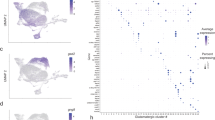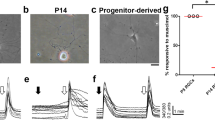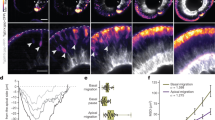Abstract
Retinal nerve fibres form an orderly map of visual space in several centres in the vertebrate brain1,2. Such topographic maps are a common feature of central nervous system organization3–5, yet the way in which they develop is poorly understood. Early nerve projections in the fetal and neonatal mammalian brain have been found in several cases to be less restricted than those in the adult6–9, suggesting that nerve fibres may initially form a diffuse set of connections in then- target structure from which the adult map is sculpted by the elimination of terminals. Indeed, previous electrophysiological data indicate that the retinotectal map in Xenopus laevis might be initially disorganized10. We report here, however, that the retinotectal projection is ordered from the beginning of tectal innervation (stage 39/40). We demonstrate this first autoradiographically by tracing groups of growing ganglion cell axons which we labelled by incubating sectors of eye rudiments, before axonal outgrowth, in 3H-proline and replacing them orthotopically. Separate labelling of dorsal and ventral parts of the initial projection showed that retinal fibres are organized topographically, as in the adult1,11, in the tectal rudiment and throughout much of the pathway. Second, we show that visual responses are ordered in the tectum from the first stage that they can be mapped (stage 40). We conclude that the topographic ordering of retinotectal connections develops as a result of directed axonal outgrowth.
This is a preview of subscription content, access via your institution
Access options
Subscribe to this journal
Receive 51 print issues and online access
$199.00 per year
only $3.90 per issue
Buy this article
- Purchase on Springer Link
- Instant access to full article PDF
Prices may be subject to local taxes which are calculated during checkout
Similar content being viewed by others
References
Gaze, R. M. Formation of Nerve Connections (Academic, New York, 1970).
Scalia, F. & Fite, K. J. comp. Neurol. 158, 455–478 (1974).
Talbot, S. A. & Marshall, W. H. Am. J. Ophthal. 24, 1255–1263 (1941).
Woolsey, C. N., Marshall, W. H. & Bard, P. Bull. Johns Hopkins Hasp. 70, 399 (1942).
Knudsen, E. I. & Konishi, M. Science 200, 795–797 (1978).
Innocenti, G. M., Fiore, L. & Cominiti, R. Neurosci. Lett. 4, 237–242 (1977).
Hubel, D. H., Wiesel, T. N. & Levay, S. Phil. Trans. R. Soc. B278, 377–409 (1977).
Rakic, P. Phil. Trans. R. Soc. B278, 245–260 (1977).
Land, P. W. & Lund, K. R. Science 205, 698–700 (1979).
Gaze, R. M., Keating, M. J. & Chung, S.-H. Proc. R. Soc. B185, 301–330 (1974).
Fawcett, J. M. J. Embryol exp. Morph. 65, 219–233 (1981).
Sperry, R. W. Proc. natn. Acad. Sci. U.S.A. 50, 703–710 (1963).
Gaze, R. M. & Jacobson, M. Proc. R. Soc. B157, 420–448 (1963).
Gaze, R. M. & Keating, M. J. Brain Res. 21, 183–195 (1970).
Meyer, R. J. comp. Neurol. 189, 273–289 (1980).
Fujisawa, H., Tani, N., Watanabe, K. & Ibata, Y. Devl Biol. 90, 43–57 (1982).
Shatz, C. J. & Rakic, P. J. comp. Neurol. 196, 287–307 (1981).
Lance-Jones, C. & Landmesser, L. Proc. R. Soc. B214, 1–18 (1981).
Grant, P., Rubin, E. & Cima, C. J. comp. Neurol. 189, 593–613 (1980).
Nieuwkoop, P. D. & Faber, J. Normal Tables of Xenopus laevis (North-Holland, Amsterdam, 1956).
Rugh, R. Experimental Embryology 3rd edn (Burgess, Minneapolis, 1962).
Holt, C. E. Nature 287, 850–852 (1980).
Scholes, J. H. Nature 278, 620–624 (1979).
Witkovsky, P., Gallin, E., Hollyfield, J. G., Ripps, H. & Bridges, C. D. B. J. Neurophysiol. 39, 1272–1287 (1976).
Rager, G. Ady. Embryol. Cell Biol. 63, 1–90 (1980).
Cowan, W. M., Martin, A. H. & Wenger, E. J. J. exp. Zool. 169, 71–92 (1968).
McLoon, S. C. Science 215, 1418–1420 (1982).
Straznicki, C., Gaze, R. M. & Keating, M. J. J. Embryol. exp. Morph. 62, 13–35 (1981).
Author information
Authors and Affiliations
Rights and permissions
About this article
Cite this article
Holt, C., Harris, W. Order in the initial retinotectal map in Xenopus: a new technique for labelling growing nerve fibres. Nature 301, 150–152 (1983). https://doi.org/10.1038/301150a0
Received:
Accepted:
Issue Date:
DOI: https://doi.org/10.1038/301150a0
This article is cited by
-
The effects of the NMDAR co-agonist d-serine on the structure and function of optic tectal neurons in the developing visual system
Scientific Reports (2023)
-
Trophic Factor-Induced Activity ‘Signature’ Regulates the Functional Expression of Postsynaptic Excitatory Acetylcholine Receptors Required for Synaptogenesis
Scientific Reports (2015)
-
Engrailed homeoproteins in visual system development
Cellular and Molecular Life Sciences (2015)
-
Neurodevelopmental effects of chronic exposure to elevated levels of pro-inflammatory cytokines in a developing visual system
Neural Development (2010)
-
Development and spike timing–dependent plasticity of recurrent excitation in the Xenopus optic tectum
Nature Neuroscience (2008)
Comments
By submitting a comment you agree to abide by our Terms and Community Guidelines. If you find something abusive or that does not comply with our terms or guidelines please flag it as inappropriate.



